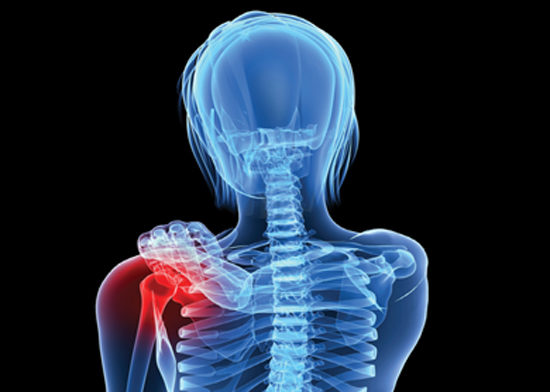Bone and joint care is one of those things many people don’t think about until something hurts. But recently, some bone and joint topics have made national headlines, which might leave your shoppers with some unanswered questions about how best to maintain bone strength and joint mobility throughout life.
The D-bate
One of the biggest bone health stories of the past year broke in late November when the Institute of Medicine (IOM) released a report recommending new dietary reference intakes (DRIs) for vitamin D and calcium. These nutrients are some of the most recognizable names in the bone health category.
IOM suggested a small bump in daily intake to 600 IUs for those ages one through 70 (including pregnant and lactating women) and 800 IUs for those over 71. The committee also increased the recommended upper limit from 2,000 IUs to 4,000 IUs for anyone older than nine.

The reactions from supplement makers were diverse. Some, like Trisha Sugarek, M.S., national educator and R&D specialist for Bluebonnet Nutrition Corporation, Sugar Land, TX, were in agreement with the report’s findings. She makes the important point that the IOM recommendation is referring to healthy individuals who don’t have a vitamin D deficiency.
Richard Passwater, Ph.D., who is in Solgar’s research and development department, adds, “The recent IOM vitamin D update was a moderate step in the right direction for a committee that deals with public health issues. The guidelines are intended to inform people about basic requirements, not optimal intakes.”
Retailers should be prepared to explain this distinction to shoppers. But the somewhat hairy area is vitamin D deficiency, a condition with which more and more patients are being diagnosed, says Patti Kim, N.D., MSOM, educator at Jarrow Formulas, Los Angeles, CA. The reason why, she says, is that our bodies should be making vitamin D from the sun, but people just aren’t spending enough time outdoors without sunscreen. “We have developed a fear of the sun to some degree as it relates to melanoma. It is important, as with all things, to achieve a balance and not expose ourselves to an excess amount of sunlight. However, some exposure is necessary for natural vitamin D production.”
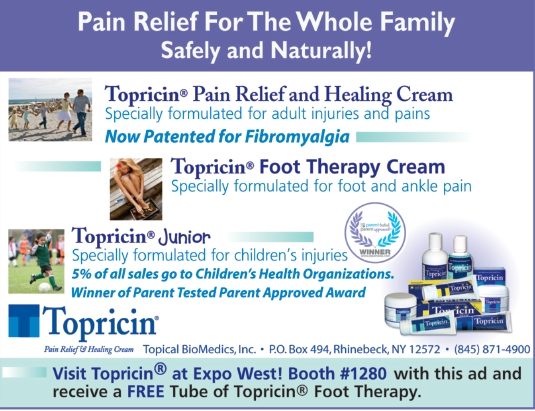 She explains some of the biology behind this. Vitamin D acts like a hormone, and its metabolic product (calcitriol) “unlocks binding sites on the human genome that are involved in virtually every human disease such as cancer, heart disease, stroke, hypertension, autoimmune disease, diabetes, depression, osteoarthritis, osteoporosis and more.”
She explains some of the biology behind this. Vitamin D acts like a hormone, and its metabolic product (calcitriol) “unlocks binding sites on the human genome that are involved in virtually every human disease such as cancer, heart disease, stroke, hypertension, autoimmune disease, diabetes, depression, osteoarthritis, osteoporosis and more.”
But, can 600 IUs a day do these jobs—especially for people with a deficiency? Chris D. Meletis, N.D., director of science and research for Trace Minerals Research, Ogden, UT, says no. As a clinician, he hasn’t found 600 IUs/day helps those with deficiencies reach optimal levels. “Yet, the BIG question is, ‘what is optimal?’” he asks, following up with, “What is the goal of the 600 IUs recommendation? If it is just to prevent overt deficiency, it could work. It is not targeted toward optimal wellness as I have observed in my clinical practice.”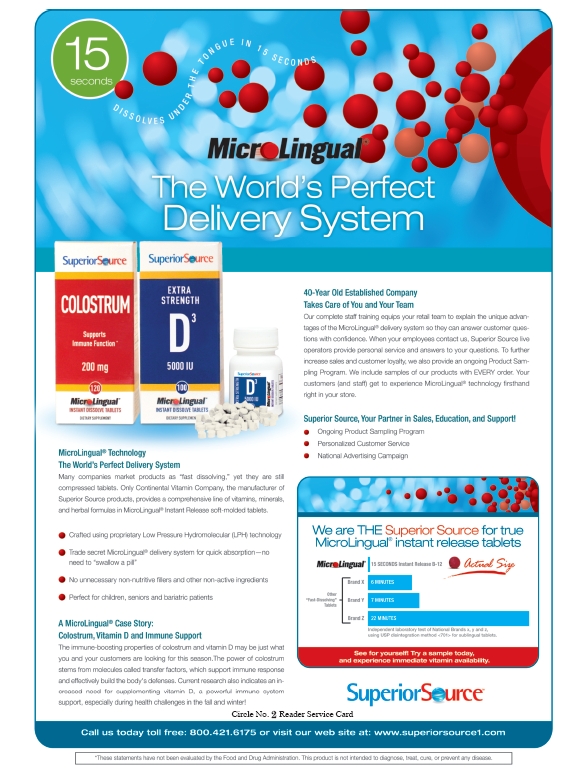
And, factors like one’s health, one’s geographical location, how much time one spends outdoors and whether sunscreen is worn all affect vitamin D synthesis. Kevin J. Ruff, Ph.D., MBA, director of scientific and regulatory affairs at Membrell, Carthage, MO, explains that “different subsets of the population should, in fact, have a higher vitamin D intake. This is especially true for women as they age, to help prevent osteoporosis.” Others who have trouble making vitamin D efficiently include breastfed infants, those with intestinal issues (like Crohn’s or celiac diseases), those with aging skin and the obese.
The bottom line for retailers is that despite the report, stores may want to carry vitamin D in a variety of dosages. But, warn clients that the official safe upper limit is 4,000 IUs per day.
Nonetheless, some research links higher vitamin D levels and wellness benefits outside bone health (though the IOM doesn’t feel the evidence is strong enough to warrant an official recommendation as of yet). Many find this perplexing. States Jonny Bowden, Ph.D., CNS, scientific advisor to Barlean’s, Ferndale, WA, “The committee looked only at the amount of vitamin D known to be needed for strong bones. That’s like evaluating an iPhone based solely on its built-in calculator. Vitamin D is important for bones, of course, but that’s only one tiny thing that this miraculous nutrient does.”
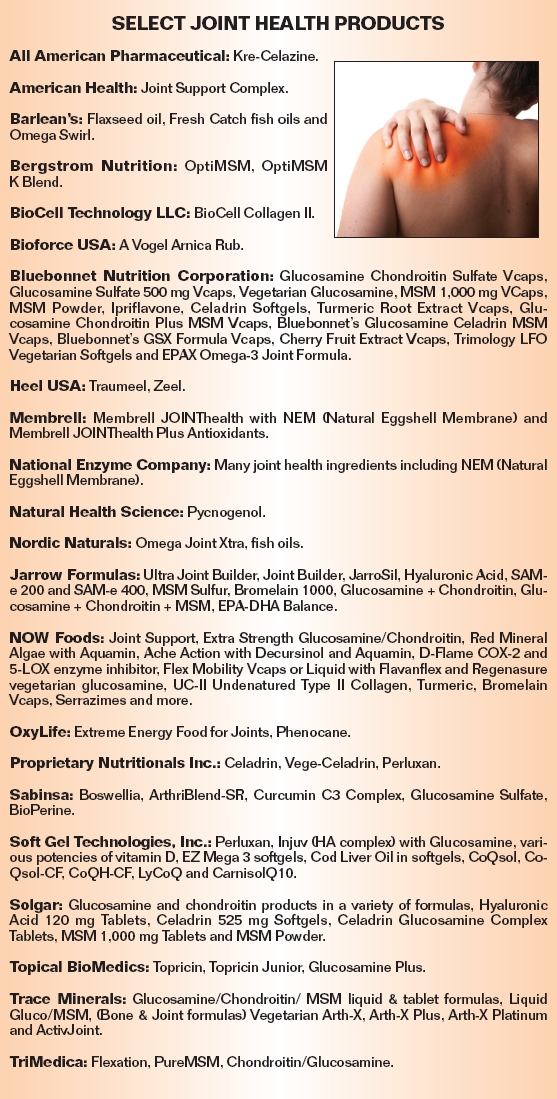 Stuart Tomc, CNHP, national educator at Nordic Naturals, Watsonville, CA, adds, “Many studies are finding a connection between low serum vitamin D levels and an increased risk of certain types of cancers, autoimmune disease, neurological disease, insulin resistance and cardiovascular disease.”
Stuart Tomc, CNHP, national educator at Nordic Naturals, Watsonville, CA, adds, “Many studies are finding a connection between low serum vitamin D levels and an increased risk of certain types of cancers, autoimmune disease, neurological disease, insulin resistance and cardiovascular disease.”
Retailers must be careful how they handle these applications. Again, the official recommendation for vitamin D doesn’t support elevated intake for these applications despite the research. Neil Levin, CCN, DANLA, nutrition education manager at NOW Foods, Bloomingdale, IL, makes the excellent point that European regulators recognize vitamin D’s beneficial effects on muscles, immunity, inflammation, cellular health and reproduction.
In the end, stores must encourage clients to talk with their healthcare providers about their health goals and which dosage of vitamin D is best for them.
Growing Pains
Also big news this past fall was the mandate from the U.S. Food and Drug Administration that makers of bisphosphonate drugs (like Boniva, Fosamax and Reclast) must warn patients that they could be linked to bone fractures. These drugs are prescribed to help build bone, but they are said to build brittle mass, which may be why bones break easily with long-term use (five years and longer).
“These drugs have not proven to be the ‘miracle’ for those with osteoporosis that they were touted to be,” says Tomc. “Building brittle bones does not seem to be the answer and the research on taking calcium and all the cofactors needed to build strong bones is still the better choice.”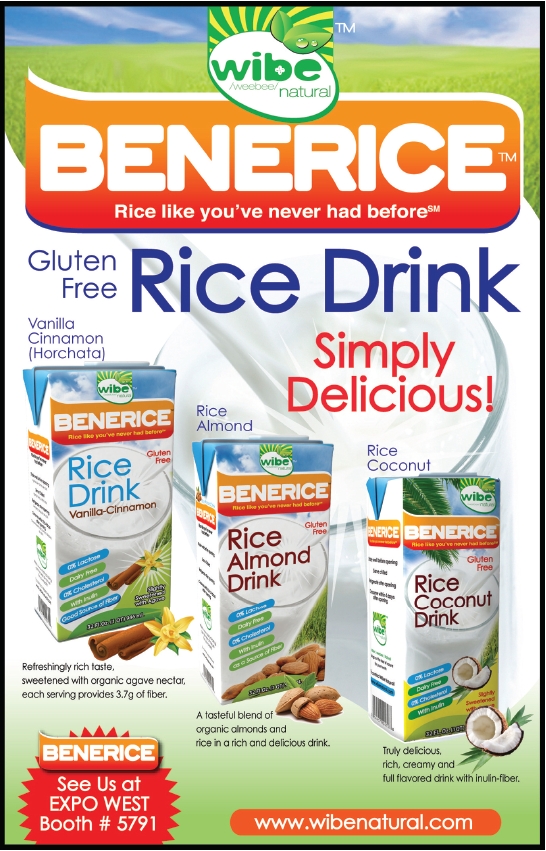
While retailers are not in a position to dispense medical advice or to dissuade shoppers from taking such prescriptions, they should be knowledgeable about how supplements support healthy bone mass.
A stand-by in this area is calcium. The skeletal system needs a consistent supply of this mineral for regular renewal of calcium in the bones. According to the National Institutes of Health, “Bones have their own ‘calcium bank account’… After age 18, the account closes—so you can’t add any more calcium to your bones. You can only maintain what is already stored to help your bones stay healthy” (1).
Nonetheless, getting enough calcium is important at all ages. Says Dean Neuls, CEO of AlgaeCal Inc., Vancouver, BC, Canada, “Calcium supports healthy bone growth through mid-30s, but after age 40, a woman loses approximately 1% of her bone density per year until death. Traditional calcium supplements have been shown to slow that normal bone loss, but not increase bone density as bisphosphonate drugs do.”
This is an important point. Says Passwater, “Healthy bone tissue is more than just calcium density…Supplying adequate calcium along with the many co-nutrients needed to assist the body to build and maintain healthy bone tissue naturally is the best approach.” The reason why, he says, is that bones aren’t just “calcium sticks.” They are living tissue composed of calcium, phosphorus, proteins, polysaccharides and other minerals, thus taking a variety of bone-supporting nutrients is important.
 Retailers shouldn’t be shy in relaying this point of view to shoppers. Says Steve Holtby, president and CEO, Soft Gel Technologies, Inc., Los Angeles, CA, “Calcium doesn’t work alone.” He notes that vitamins A, D and C and magnesium are needed for bone formation, too, as is exercise.
Retailers shouldn’t be shy in relaying this point of view to shoppers. Says Steve Holtby, president and CEO, Soft Gel Technologies, Inc., Los Angeles, CA, “Calcium doesn’t work alone.” He notes that vitamins A, D and C and magnesium are needed for bone formation, too, as is exercise.
And, tell shoppers that calcium intake must be balanced; taking too much calcium by itself may lead to magnesium deficiencies that are associated with osteoporosis. Experts say that the best calcium–magnesium ratio is 2:1. To ensure consumers have the right balance, Ken Whitman, president of Peter Gillham’s Natural Vitality, Austin, TX, advises, “Before taking supplemental calcium, dietary calcium should be added up,” since the recommendation of 1,200 mg of calcium per day is total intake (not just from supplements).
Lifestyle changes can support healthy bones, too. According to Nena Dockery, scientific and regulatory affairs manager at National Enzyme Company, Forsyth, MO, these include eating foods that naturally contain bone-health nutrients, getting sun exposure (about 10–15 minutes of unprotected exposure per day) and doing weight-bearing exercise.
Other members of the bone health family. So, other than calcium, which important bone health supplements should you keep in stock?
• Vitamin D, which helps with calcium absorption, says Levin, as do boron, vitamin C and protein. According to Kim, boron helps protect against urinary loss of calcium and magnesium, while vitamin C has been associated with increased bone mineral density. Vitamin C, though sometimes overlooked by shoppers in the bone health category, is important, says Angelica Vrablic, Ph.D., manager of nutrition research at American Health, Ronkonkoma, NY. “Often, we overlook the fact that bone is 50% mineral and 50% protein. The protein in human bone is collagen and vitamin C is essential for collagen production,” she states, adding that for this reason, her firm recently launched a vitamin D— Ester-C (a branded vitamin C ester) combo supplement. This formula includes the dose of vitamin D (5,000 mg) that “was clinically shown to maintain healthy bone density measures with small amounts of calcium in older individuals (2),” states Vrablic.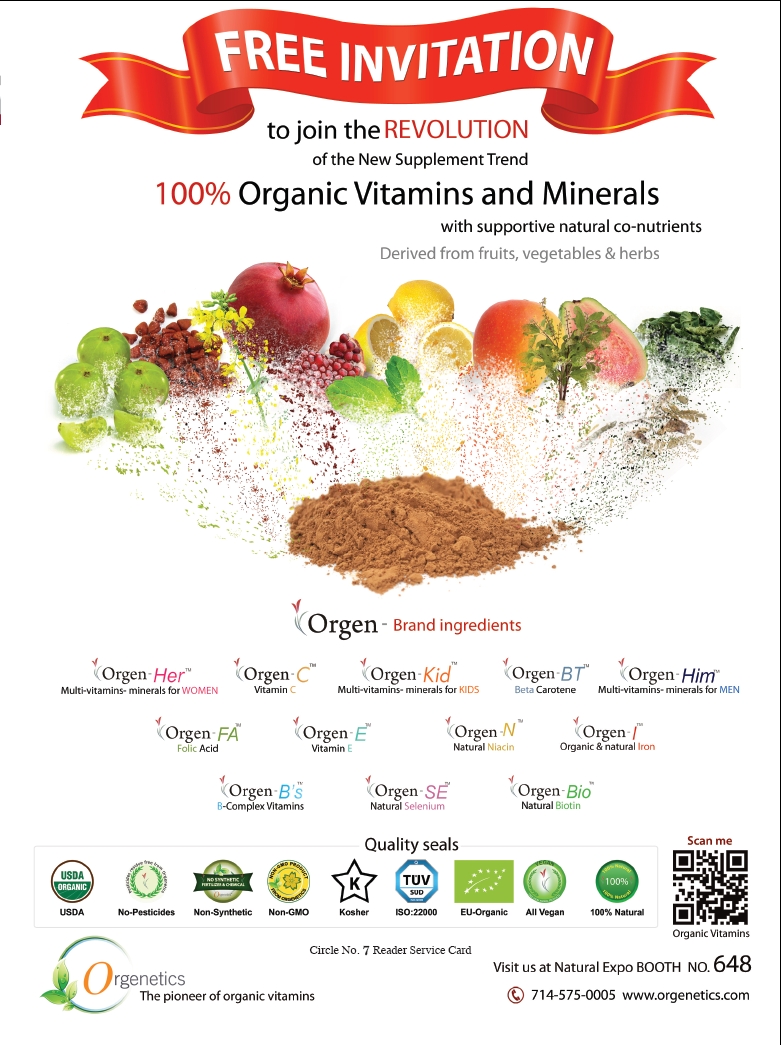
• Fish oil is also important, Tomc believes, since omega-3s “have been shown to positively influence bone formation and are associated with bone mineral density.” Many consumers don’t think of fish oil as a bone support supplement, but this attitude might be changing. Says Bowden, “I think you will start to see a growing recognition of the inflammatory component in bone problems, and a need to include omega-3s on a regular basis as part of an overall bone preservation and bone health program.”
• Vitamin K2 may help regulate bone metabolism. Without enough vitamin K in the body, calcium cannot be transported properly. Says Sugarek, “K2 increases bone formation and decreases bone reabsorption in the body for optimal bone health and density,” noting that this vitamin activates osteoblasts, “which lay down the osteocalcin in the bone, allowing the calcium to bind and making the bones dense and strong.” In addition, vitamin K may also affect bone turnover by inhibiting calcium reabsorption.
• Silica, says Eileen Sheets, managing director of Bioforce USA, Ghent, NY, “helps to store calcium in the bones and strengthen the structure of the tissue.”
• Magnesium helps maintain bone density by helping with calcium absorption, but it’s also “vitally important at a cellular level,” says Whitman. If one doesn’t get enough magnesium, the body will steal it from the bones.
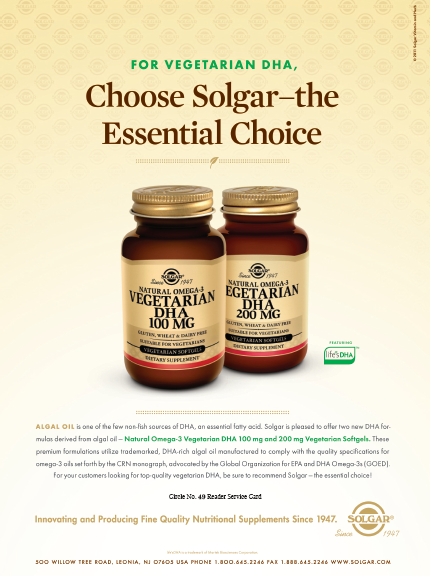 Bone Health from the Get-Go
Bone Health from the Get-Go
During childhood and the teenage years, the bones store the calcium they need for later in life. Says Sugarek, “By age 18, more than 90% of adult skeletal mass will be formed.” Therefore it’s important that retailers remind parents that bone health supplements are appropriate for some children, too.
“Sooner is better,” says Meletis, noting that the bulk of a child’s nutrition should come from good diet and exercise first. “In my clinical practice, I like to make sure children that are at risk are on a good bone protocol by age four,” he says, however.
Also noting that early emphasis on bone health nutrients is important, Sheets says, “Once a baby is born the benefits of breastfeeding cannot be over emphasized. The nutritional value of the breast milk is exactly what a baby needs and can digest and utilize. Today it is recommended to supplement with vitamin D as well.”
Thereafter, Bob L. Owen, Ph.D., an independent nutritional consultant for Coral LLC, Carson City, NV, suggests “encouraging plenty of fresh air, sunshine (vitamin D) and outdoor exercise, adequate rest and sleep, diets of organic food and supplementation to provide the child with a proper wide spectrum of vitamins, minerals, amino acids and fats and oils.”
But, don’t let this discourage anyone from taking bone health supplements (with the approval of a healthcare provider). Says Passwater, “Bones are living tissues and not rocks. They must be constantly nourished. Even lifelong under-nutrition can be reversed by proper diet, supplementation and exercise.”
Joint Effort
Let’s switch gears a bit and focus on the related category of joint health. If you’re like many retailers, you may have noticed an increase in consumers looking for joint pain relief. According to Holtby (who cites a Packaged Facts report), the joint health category has become the largest market of condition-specific dietary supplements, worth $174 million in 2007. He states, “With the prevalence of chronic joint pain and the dangers presented by pharmaceutical drugs, it’s no surprise that sales of joint health supplements have recently soared.”
A look at some recent research initiatives may help us to better understand the coming trends in this category.
Combinations. New research on joint-health nutrients is increasingly focused on how supplementation can affect several functions in the body for optimal wellness. This technique is quite different from drugs, which often focus on one mechanism of action. Kim gives us the great example of omega-3 fatty acids, which don’t mask joint pain, for instance. Rather, research supports their ability to reduce inflammation, which can benefit those looking for extra joint mobility, reduced pain and more. “Natural medicine is a dance between alleviating symptoms while also treating the deeper causes of disease,” she states.
Omegas are even being studied as part of traditional treatment plans for those with arthritis. In a 2009 study, a group of rheumatoid arthritis patients were given their typical dosage of indomethacin (a non-steroidal anti-inflammatory drug [NSAID]) or the drug plus omega-3 fatty acids (3 g) daily for three months (3). Overall, those in the omega-3 plus indomethacin group had better improvement in their disease symptoms than the drug-only group.
 Natural compound combinations are another area of interest. Says Tomc, “The latest human clinical trials show that the combination of EPA+DHA from fish oil and glucosamine sulfate work better together than glucosamine sulfate alone.” Some 177 osteoarthritis patients were either given glucosamine sulfate (1,500 mg/day) and EPA/DHA or just glucosamine sulfate (4). More participants in the combination group had reduced osteoarthritis symptoms than in the glucosamine group (49%–56% versus 42%–55%).
Natural compound combinations are another area of interest. Says Tomc, “The latest human clinical trials show that the combination of EPA+DHA from fish oil and glucosamine sulfate work better together than glucosamine sulfate alone.” Some 177 osteoarthritis patients were either given glucosamine sulfate (1,500 mg/day) and EPA/DHA or just glucosamine sulfate (4). More participants in the combination group had reduced osteoarthritis symptoms than in the glucosamine group (49%–56% versus 42%–55%).
Bowden also brings up another important joint-health pair: glucosamine and chondroitin. He states, “I think there continues to be substantial evidence that glucosamine sulfate and chondroitin sulfate in combination can help many people. In addition, the massive evidence for the anti-inflammatory properties of omega-3s make them an essential part of any program for joint health and pain reduction.”
Similarly, ingredients that are naturally rich in several joint health nutrients are increasingly in demand. States Dockery, “One of the most interesting ingredients for joint health right now is an ingredient offered from ESM Technologies. The ingredient, NEM, is produced from egg shell membrane and contains natural sources of glucosamine, hyaluronic acid and collagen, all of which are joint-supporting compounds.”
Ruff of Membrell notes that clinical trials on this ingredient found it to be “effective in a gold-standard double-blind placebo-controlled trial in as little as 10 days. This is a very rapid-acting effect, particularly for a small dose of 500 mg, once per day.”
Wear and tear. One common joint ailment, osteoarthritis, is known as a “wear and tear” disease. Experts says this progressive disease occurs when the cartilage around the joints wears away, making the bones rub up against each other. At the same time, the joints’ synovial fluid cannot properly lubricate the area (5). “Deterioration of the cartilage tissue matrix and lubricating ability of the synovial fluid will ensue, causing fatigue, weakness, aches, frequent injuries and overall lack of performance,” says Joosang Park, Ph.D., vice president of scientific affairs of BioCell Technology LLC, Newport Beach, CA.
Thus, according to Park, it is important to replenish the nutrients needed for healthy cartilage function, adding that some research is now focusing on natural supplements that support the structural components of the cartilage. One such botanical is collagen. “One of the most interesting studies is a human clinical trial of cartilage-derived joint health supplement called BioCell Collagen II in osteoarthritic subjects,” he states. Park notes that those who took this ingredient, “had significant reduction of pain and stiffness and substantial improvement of physical activities in their daily life.”
Other supplements said to support collagen formation include chondroitin, hyaluronic acid, glucosamine and other sulfur-containing agents like MSM, says Sugarek.
COX-2 research. Those with joint problems like arthritis are familiar with the term COX-2 inhibitors. The body uses cyclooxygenase-1 (COX-1) for kidney and platelet function while COX-2 is found at sites of inflammation (6). Many NSAIDs inhibit both COX-1 and COX-2, which stops inflammation while also potentially causing side effects like ulcers and other issues. Holtby explains that the COX-2 enzyme acts like a spark plug to ignite the pro-inflammatory omega-6 fatty acid arachidonic acid. He states, “That ‘fire’ is needed: it helps the body defeat enemies like bad bacteria, and helps it marshal its forces to respond to trauma and injury. But sometimes, the fire burns too hot or gets out of control, and when that happens, our bodies can be casualties of ‘friendly fire.’”
 Though botanical compounds don’t perform like drugs and aren’t treatments, one important area of research interest is examining how plant-based and herbal compounds affect the COX-2 enzyme. Holtby says some scientists even used natural elements as models for synthetic COX-2 inhibitors. Herbs that have been the subject of such research include green tea, ginger, turmeric, holy basil, chamomile, Chinese goldthread, barberry, Baikal skullcap, Hu zhang (Japanese knotweed), rosemary, hops, feverfew and oregano, says Holtby, adding, “A blend of the appropriate extracts of those herbs, if sufficiently concentrated, may offer substantial relief from the ‘fires’ of COX-2 inflammation, without the known and unknown side effects of synthetic drug inhibition.”
Though botanical compounds don’t perform like drugs and aren’t treatments, one important area of research interest is examining how plant-based and herbal compounds affect the COX-2 enzyme. Holtby says some scientists even used natural elements as models for synthetic COX-2 inhibitors. Herbs that have been the subject of such research include green tea, ginger, turmeric, holy basil, chamomile, Chinese goldthread, barberry, Baikal skullcap, Hu zhang (Japanese knotweed), rosemary, hops, feverfew and oregano, says Holtby, adding, “A blend of the appropriate extracts of those herbs, if sufficiently concentrated, may offer substantial relief from the ‘fires’ of COX-2 inflammation, without the known and unknown side effects of synthetic drug inhibition.”
One branded hops extract (Perluxan from Proprietary Nutritionals, Inc., Kearny, NJ, and Soft Gel Technologies) is said to offer these benefits. Adds Holtby, “The subject of multiple in vitro, ex vivo and in vivo human clinical trials, Perluxan moderately inhibits COX-2 and mildly inhibits COX-1, and is well-tolerated and does not cause gastrointestinal distress.”
Another ingredient, an extract of the French maritime pine bark (Pycnogenol from Natural Health Science), also has been studied for its ability to inhibit COX-1 and COX-2 activity (7). In one study, 300 mg of Pycnogenol significantly inhibited COX-1 and COX-2 after just 30 minutes. According to information from the company, the extract also stops the activation of the pro-inflammatory NF-kB: “The activated NF-kB protein commands the mobilization of essentially all pro-inflammatory molecules which play a destructive role in arthritis. As a consequence of NF-kB inhibition, immune cells of Pycnogenol consumers generate less MMP enzymes which are responsible for degenerating cartilage collagen in osteoarthritis [Grimm et al., 2006].”
Cherry extract is also studied for its ability to block COX-1 and COX-2 enzymes and lower uric acid levels. Elevated uric acid levels are associated with gout, a form of arthritis. Sugarek cites some 2002 research from the U.S. Department of Agriculture and the ARS Western Human Nutrition Research Center in which cherry juice decreased plasma uric acid in healthy women. “Researchers hypothesize that compounds in cherry fruit may inhibit the inflammation pathway associated with gout and further clinical studies are advised,” she states.
Last, curcumin has gotten increased attention in joint-health research circles for its ability to inhibit lipoxygenase, nuclear kappa B (NF-KB) and COX-2. In one small-animal study, turmeric was found to prevent joint inflammation effectively, leading researchers to suggest that “turmeric may have potential as agents in the prevention and treatment of rheumatoid arthritis. Additional research including human clinical trials is necessary before any specific recommendations can be made” (8).
Fast and Long-Term Support
Understandably, shoppers with aching joints are looking for immediate relief. Some joint health products are faster acting than others, so retailers should be prepared to discuss both long-term and short-term relief products with patients.
Supplements often take a longer time to take effect than a pharmaceutical drug because they “work alongside the body’s own healing mechanisms and therefore their positive effects are slower to be realized than the immediate relief from a pharmaceutical pain-reliever or anti-inflammatory,” says Dockery. Addressing some of the root triggers of joint pain (like inflammation) may work out very well for some people who are willing to wait for natural products’ benefits to be seen. 
For instance, glucosamine or fish oil may take one to two months to take effect (depending on the individual’s condition). But, Levin says these supplements are worth waiting for. “One should not neglect the long-term benefits of glucosamine to maintain joint distances that may otherwise erode, for example, while seeking fast-term temporary relief of aches and pains,” he states.
Thus, consider directing shoppers to products in both ends of the category; some companies even set up their product lines in this manner. For instance, NOW Foods separates its joint support category into two sections: Joint Structural Support Products and Joint Pain & Mobility Products. “This suggests to the customer that they need ‘one from column A and one from column B,’” says Levin.
But, to ensure consumers are happy with the supplements they are taking, be sure to tell them to have patience with certain products. Says Chris Haynes, director of sales at Membrell, “Consumer expectations need to be in line with the possibilities. Retailers need to know and be able to communicate study results in practical terms.”
Some topicals offer relief in the meantime. For instance, Kristy Anderson, NMD, medical advisor of bioregulatory medicine, Heel USA, Albuquerque, NM, says that consumers with mild joint pain may find temporary relief in a homeopathic drug made by her company (Zeel, topical or tablets). The natural ingredients in this combination product, says Anderson, “work together to provide relief of symptoms of osteoarthritis and support healthy function of connective tissue, cartilage, tendons and ligaments.”
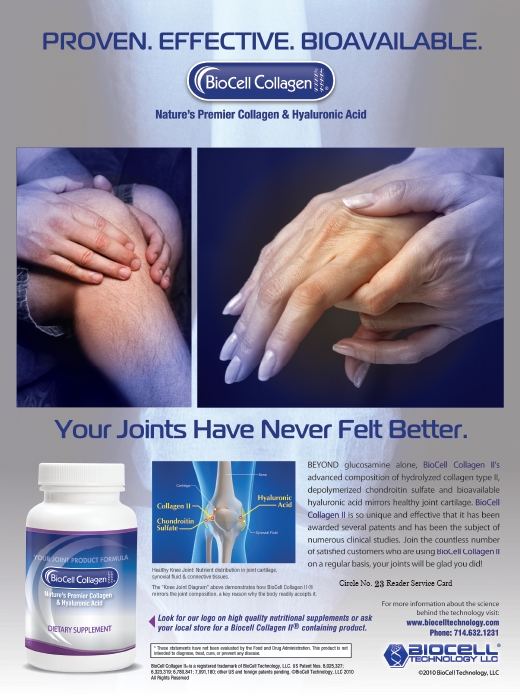 She says in a trial of 498 people, “patients experienced rapid and definite relief from such complaints as pain during the night, pain upon first motion and pain during joint movement. The participating physicians assessed overall results of therapy as either very good or good for 75% of the patients” (9).
She says in a trial of 498 people, “patients experienced rapid and definite relief from such complaints as pain during the night, pain upon first motion and pain during joint movement. The participating physicians assessed overall results of therapy as either very good or good for 75% of the patients” (9).
Another fast-acting product, says Sheets, is arnica in a topical gel form. “It is particularly helpful to use while waiting for your nutritional program to kick in,” she states.
Similarly, a branded homeopathic topical product (Topricin from Topical BioMedics) is said to “work synergistically to help the body heal the damaged cells that are causing pain in joint, nerve and muscle tissue.” The product is said to quickly restore mobility and motion by supporting chemistries that enhance healing, rather than suppressing pain.
It’s not just topicals that offer quick relief. Haynes speaks of a tableted formulation that may offer relief in days. “If there are products like Membrell’s JOINThealth and JOINThealth Plus Antioxidants which are clinically shown to provide 10 days results, consumers should be made aware of their options.”
A proprietary hops extract (Perluxan from Proprietary Nutritionals, Inc.) is said to have a fast-acting effect on relieving discomfort and significant improvement over placebo after two hours following the first dose, according to Dean Mosca, president. He adds that a branded esterified fatty acid (Celadrin) has been studied topically for immediate relief. Taken orally, benefits are seen after two weeks.
But retailers should never say that supplements work like fast-acting drugs. Says Bowden, “You don’t take supplements like you do an asprin and expect results in 20 minutes. They work synergistically over time, to correct and repair processes that contribute to pain, discomfort and other problems. Using natural nutrients to correct joint pain requires a longer timeframe—at least a month—though I have seen in clinical practice MUCH quicker results with large (2–3 grams daily) doses of omega-3 fats.”
Jump Start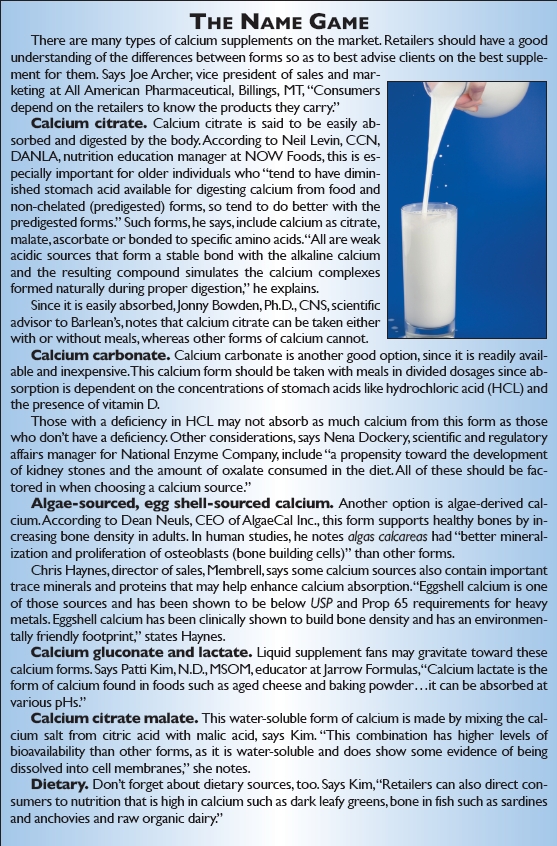
Though joint problems may seem to shoppers like they surface out of the blue, joint pain is often the result of long-term wear and tear. So, tell shoppers to take the bull by horns to support joint health before joint pain and stiffness develops. And, as Joe Archer, vice president of sales and marketing at All American Pharmaceutical, Billings, MT, reminds us, “Just like most things, it is never too late to start a support program.”
For instance, young and middle-age adults can take care of the joints by not partaking in exercises that are too difficult or heavy weigh-lifting. Plus, Dockery notes that maintaining a healthy weight also supports joint health. “Exercise is probably the ‘double-edged sword’ in joint health,” she says. “Proper stretching exercises can often minimize the joint, ligament and tendon injuries. Stretching is also important as we age and joint support tissue begins to be less capable of self-healing from minor injuries.”
Mosca makes the point that as people age, they should partake in activities that are less destructive on joints. Even seemingly harmless activities like poor posture or excessive typing (cell phones included!) might cause joint pain over time. “This is why dietary supplementation—to provide targeted nutritional support for the structure and function of the joints—is a smart routine for younger people to start,” he states.
First, individuals should try to ensure they are getting a proper omega-6–omega-3 balance. Holtby offers some advice for correcting an imbalance between such pro- and anti-inflammatory agents: “From a dietary standpoint, this means switching from vegetable oils to extra-virgin olive oil (high in anti-inflammatory omega-9 fatty acids). It also means avoiding most processed (boxed, canned, or frozen) foods, because their makers frequently add omega-6 fatty acids. By eating simple unprocessed foods—such as baked chicken, a salad and steamed vegetables—it becomes easier to consume a more balanced ratio of omega-6 and omega-3 fatty acids.”
Dockery believes antioxidant-rich foods will help avoid free-radical damage and control extraneous inflammation. She states, “Supplements containing a rich source of omega-3 fatty acids will help support the joints, as will ingredients such as glucosamine, chondroitin, MSM, hyaluronic acid and collagen. Supplements containing anti-inflammatory nutrients such as turmeric (curcumin), Boswellia or resveratrol are also advantageous, especially in conjunction with specific high activity proteolytic enzymes.” Supplemental fish oil can also help promote healthy connective tissue and joint cartilage while keeping inflammation under control. WF
References
1. National Institutes of Health, “Bone Health,” www.nichd.nih.gov/health/topics/bone_health.cfm, accessed Dec. 21, 2010.
2. V. Mocanu et al., “Long-term effects of giving nursing home residents bread fortified with 125 microg (5000 IU) vitamin D(3) per daily serving,” Am. J. Clin. Nutr. 89 (4):1132–1137 (2009).
3. A.B. Das Gupta et al., “Role of Omega-3 Fatty Acid Supplementation with Indomethacin in Suppression of Disease Activity in Rheumatoid Arthritis,” Bangladesh Med Res Counc Bull. 35 (2), 63-68 (2009).
4. J. Gruenwald et al., “Effect of Glucosamine Sulfate With or Without Omega-3 Fatty Acids in Patients With Osteoarthritis,” Adv. Ther. 26 (9), 858–871 (2009).
5. American Academy of Orthopaedic Surgeons, “Osteoarthritis,” http://orthoinfo.aaos.org/topic.cfm?topic=a00227, accessed Dec. 27, 2010.
6. J.M. Bathon, “Osteoarthritis—Treatment Information,” www.hopkins-arthritis.org/arthritis-info/osteoarthritis/osteo_new_treat.html, accessed Dec. 27, 2010.
7. A. Schafer et al., “Inhibition of COX-1 and COX-2 Activity by Plasma of Human Volunteers after Ingestion of French Maritime Pine Bark Extract (Pycnogenol),” Biomed. Pharmacother. 60 (1), 5–9 (2006).
8. J.L. Funk et al., “Turmeric Extracts Containing Curcuminoids Prevent Experimental Rheumatoid Arthritis,” J. Nat. Prod. 69 (3), 351–355 (2006).
9. R.E. Wodick et al., “The Biological Treatment of Articular Affections,” Biological Med. 3, 127–135 (1993).
Published in WholeFoods Magazine, February 2011

